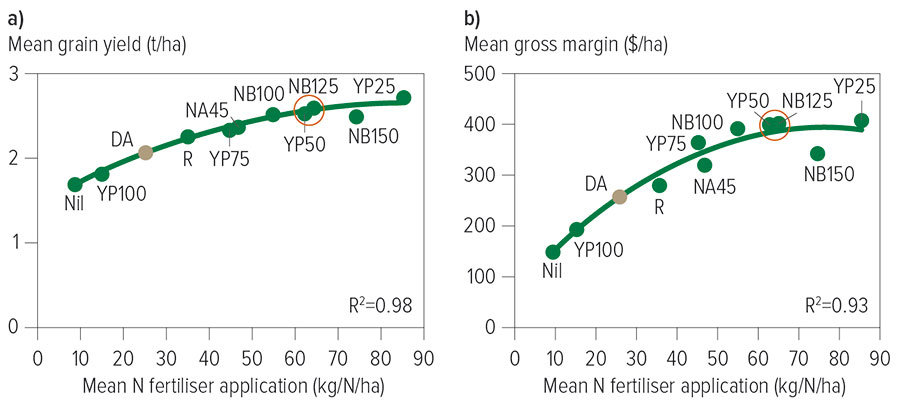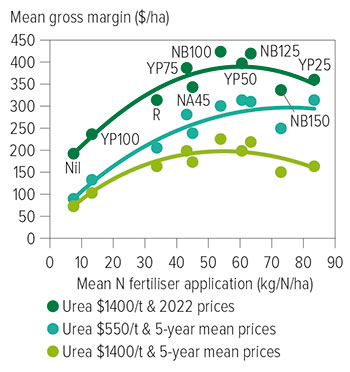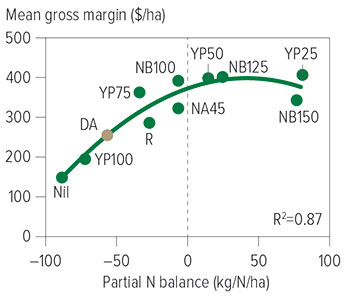Key points
- Current seasonal risk approaches to nitrogen fertiliser are often based on the assumption that nitrogen fertiliser is a lost cost if it is not used in the year of application
- One Victorian trial has shown a simpler approach based on nitrogen banking can improve soil fertility, long-term yield and gross margins
Nitrogen fertiliser is a costly input and its use increases the cost of production and Value at Risk (VaR) for growers. The idea of applying sufficient nitrogen to maximise yields regardless of the season is a source of trepidation for many growers and advisers.
Instead, many try to match nitrogen fertiliser to seasonal yield potential – but Australia’s highly variable seasonal rainfall and the limited predictability of seasonal forecasts make this difficult.
The cost of nitrogen fertiliser is a factor in these decisions, but concerns about the potential for crops to hay-off under high nitrogen and terminal drought stress, and environmental losses of nitrogen through volatilisation, denitrification and leaching, also play a role.
It is often assumed that if nitrogen from fertiliser is not taken up by the crop in the year of application, it is a lost cost. However, unused fertiliser plays a vital role in maintaining the fertility of continuous cropping systems and is taken up by crops at least two years after the initial application.
Wheat crops typically only extract about 30 to 40 per cent of their nitrogen requirement from fertiliser. The most important source of nitrogen for crops – about 60 to 70 per cent – is the ‘bank’ of mineral nitrogen that is already in the soil, or which mineralises from organic nitrogen during crop growth.
On average, less than half of nitrogen fertiliser is taken up by crops in the year of application, making unused fertiliser the biggest source of ‘deposits’ into the nitrogen bank in continuous cropping systems.
In medium and low-rainfall regions with heavy textured soils, the majority of applied nitrogen that is not used in year of application will remain in the soil for use in subsequent seasons and is not a lost cost. This means there is little downside risk to occasional over-application of nitrogen, provided cashflow can be managed.
While it might seem pragmatic to reduce risk by lowering nitrogen applications, the result is a chronic long-term decline in soil organic nitrogen and a corresponding reduction in soil organic matter. A whole-of-system approach is needed to rebuild crop potential.
Nitrogen management systems such as Yield Prophet® and nitrogen banking, which use a soil test for mineral nitrogen, have been shown to increase both profitability and sustainability of cropping systems.
Measuring profitability
In 2018, the Birchip Cropping Group established a field trial to evaluate strategies for top-dressed nitrogen at Curyo with pilot funding from La Trobe University. The site was supported by the Mallee Catchment Management Authority through Landcare funding from 2019 to 2021.
The strategies were:
- replacement – replacing the nitrogen removed in grain;
- national average – 45 kilograms nitrogen per hectare;
- nitrogen banks – soil mineral nitrogen plus fertiliser total of 100, 125 or 150kg of nitrogen/ha (NB100, NB125 and NB150);
- Yield Prophet® probabilities – YP100 (100 per cent chance of achieving target yield, decile 1 rainfall required), YP75 (75 per cent, decile 2 to 3), YP50 (50 per cent, decile 4 to 7) and YP25 (25 per cent, decile 8 to 9); and
- nil – only starter nitrogen was applied.
Figure 1: Both nitrogen banking (NB) and the Yield Prophet® (YP) strategies closed the yield gap (1a) and improved gross margins (1b) at Curyo, Victoria. Sum of results for 2018 to 2021 with five-year average costs and prices. NA = national average, R = replacement.

Source: James Hunt, University of Melbourne
The first year (2018) was dry with little rainfall after the nitrogen was top-dressed, yet soil testing at the start of 2019 found 58 per cent of applied fertiliser nitrogen remained as mineral nitrogen and had moved into the soil profile. It is unknown how much of the remainder had been immobilised into organic nitrogen and how much was lost from the system.
Figure 2: The nitrogen banking (NB) and the Yield Prophet® (YP) strategies remained profitable even with the higher fertiliser prices observed in 2022, regardless of whether the grain prices were based on the five-year average or the higher 2022 prices. NA = national average, R = replacement. 
Source: James Hunt, University of Melbourne
Both the nitrogen banking and Yield Prophet® strategies were able to close the yield gap and improve gross margins (Figure 1) by profitably alleviating nitrogen deficiency. But the banking approach is simpler and less time-consuming than the seasonal risk-based approach as it does not rely on calculations of seasonal yield potential.
These strategies remained profitable even when the fertiliser price increases observed in 2022 were used to calculate gross margins.
These profits held, regardless of whether the grain prices were based on the five-year average or the higher 2022 prices (Figure 2). Using a urea price of $1400 per tonne and 2022 grain prices, the most profitable strategies were YP50 and NB125.
Positive N balances
The most-profitable strategies had a small positive nitrogen balance (Figure 3), whereas the district average mined an average of 50kg of nitrogen/ha in soil organic nitrogen and, in theory, about 600kg/ha of soil carbon.
Legumes and organic wastes could provide effective alternatives to nitrogen fertilisers while prices are high but, regardless of the source, high grain prices mean investment in nitrogen is well worth the expense.
While the field research has only been conducted at a single location over a limited number of years, crop simulation modelling suggests the findings are applicable across a wide range of rainfalls and soil types.
Figure 3: The most profitable systems (total for the four years 2018 to 2021) had a small positive nitrogen balance. NB = nitrogen banking, YP = Yield Prophet®, NA = national average, R = replacement. 
Source: James Hunt, University of Melbourne
The most-profitable nitrogen bank target depends on environmental yield potential and ranges from 80kg of nitrogen/ha in low-rainfall environments to 275kg/ha in high-rainfall environments.
More work is needed to confirm the value of nitrogen banking in multiple environments, including quantifying the potential for losses in different soil types and rainfall zones.
To achieve this aim, GRDC invested in the Curyo trial in 2022 and added 11 new field sites in Victoria and South Australia, and four in southern New South Wales.
These were managed by Birchip Cropping Group and FarmLink and preliminary results are expected to be delivered in March 2023.
More information: Professor James Hunt, 0428 636 391, james.hunt@unimelb.edu.au, BCG: The N Bank – A nitrogen management strategy

























































